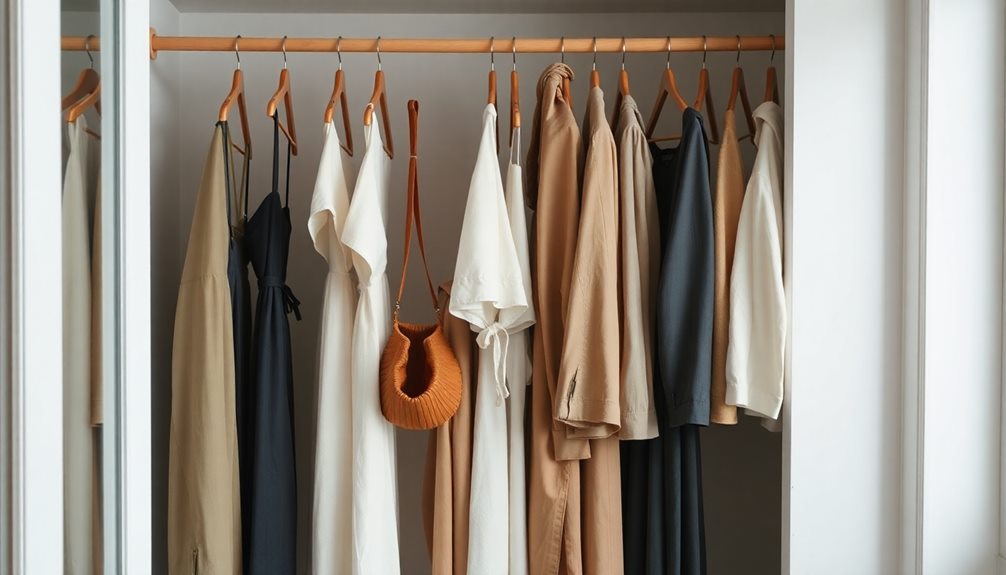Creating a sustainable fashion capsule wardrobe is a smart way to streamline your style and reduce your carbon footprint. Start with 30-40 essential pieces like a perfect white t-shirt, tailored trousers, and classic blue jeans. Stick to a cohesive color palette for easy mixing and matching. Use versatile accessories to elevate outfits and experiment with layering for different looks. Keep your wardrobe updated seasonally to maintain relevance. By choosing quality, eco-friendly materials, you're not just enhancing your style but also supporting ethical practices. Keep exploring to find more tips for building and styling your capsule wardrobe effectively.
Key Takeaways
- A sustainable fashion capsule wardrobe consists of 30-40 versatile pieces that promote mindful consumption and reduce environmental impact.
- Essential items include a perfect white t-shirt, tailored trousers, classic blue jeans, and high-quality materials like organic cotton and linen.
- Establish a cohesive color palette and regularly update your wardrobe to reflect changing styles and seasonal needs.
- Accessories play a crucial role in enhancing outfits and should prioritize quality and eco-friendly materials for sustainability.
- Regularly evaluate non-capsule items and apply a "one-in-one-out" rule to maintain a streamlined and functional wardrobe.
What Is a Capsule Wardrobe?
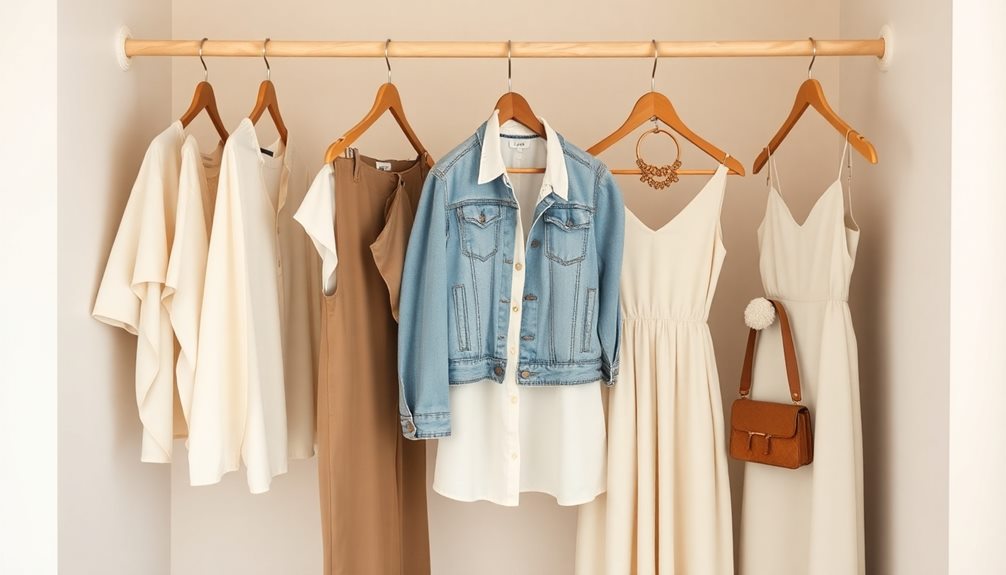
A capsule wardrobe is fundamentally a curated collection of 30-40 essential clothing items that simplifies your dressing routine. This concept revolves around selecting versatile pieces that can be mixed and matched, allowing you to create multiple outfits without cluttering your closet.
By focusing on classic staples like basic tops, tailored bottoms, outerwear, and versatile footwear, you can easily express your personal style while embracing sustainable fashion.
The idea of a capsule wardrobe gained popularity in the 1970s and was popularized by Donna Karan's "Seven Easy Pieces" collection in 1985. It encourages mindful consumption, promoting high-quality, timeless pieces that stand the test of time.
Instead of following fleeting fashion trends, you'll find that a capsule wardrobe emphasizes a cohesive color palette, making it easier to coordinate your outfits.
Regularly updating your capsule wardrobe with seasonal adjustments helps maintain its relevance and functionality.
Benefits of Sustainable Fashion
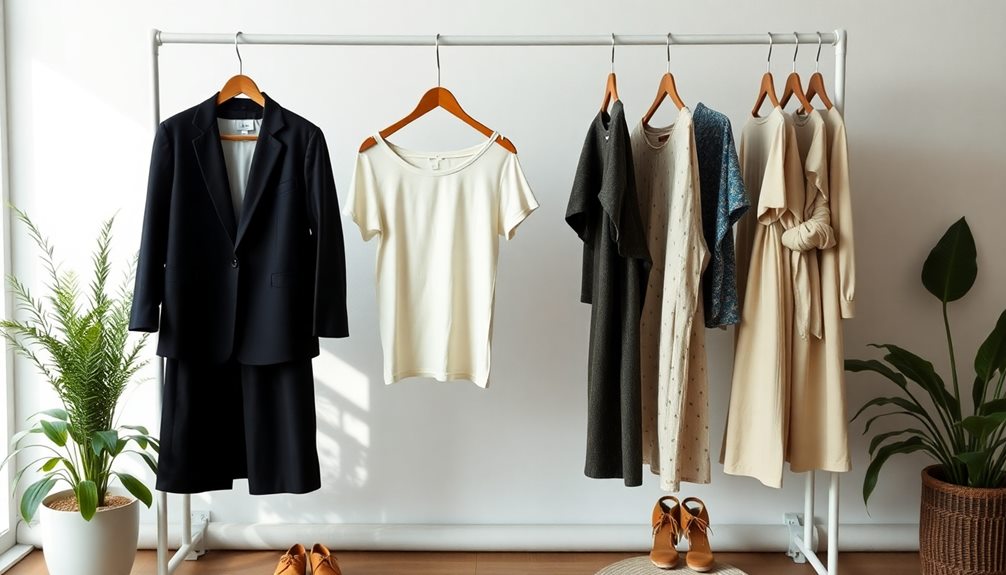
When you choose sustainable fashion, you're actively reducing your environmental impact by minimizing waste and supporting eco-friendly materials.
Plus, by prioritizing ethical production practices, you help guarantee that workers are treated fairly and work in safe conditions.
This conscious approach not only benefits the planet but also promotes a more responsible fashion industry.
Environmental Impact Reduction
Choosing sustainable fashion practices not only benefits the environment but also helps you make more mindful decisions about your wardrobe. By embracing a capsule wardrobe, you can greatly reduce your environmental impact. The fashion industry contributes to around 10% of global greenhouse gas emissions, and by opting for high-quality, sustainable pieces, you actively decrease your carbon footprint.
Investing in durable items means you're less likely to fall into the fast fashion trap, where garments are quickly discarded after a few wears. This approach also minimizes textile waste; the average American tosses about 81 pounds of clothing each year, which only adds to landfill overflow.
Moreover, sustainable fashion encourages the use of eco-friendly materials like organic cotton and recycled polyester, which require far less water and energy than conventional fabrics. By choosing these options, you're not only making a fashion statement but also supporting a healthier planet.
Ethical Production Practices
Sustainable fashion isn't just about reducing environmental impact; it also emphasizes ethical production practices that benefit workers and communities. When you choose a sustainable brand, you support fair labor conditions, ensuring workers receive fair wages and work in safe environments. This creates a more equitable industry and fosters community growth.
Many sustainable brands prioritize eco-friendly materials, like organic cotton or recycled fabrics, helping to reduce environmental impact while conserving precious resources. You can feel good knowing that your choices promote responsible production methods.
Transparency in supply chains plays a significant role here, allowing you to make informed decisions about where your clothing comes from and its overall impact.
Additionally, supporting local production not only strengthens local economies but also reduces the carbon emissions linked to transporting goods over long distances. By focusing on creating timeless pieces designed for longevity, these brands help decrease waste and combat the fast fashion mentality.
Incorporating ethical production practices into your wardrobe means you're not just buying clothes; you're investing in a better future for workers, communities, and the planet.
Essential Pieces for Your Wardrobe
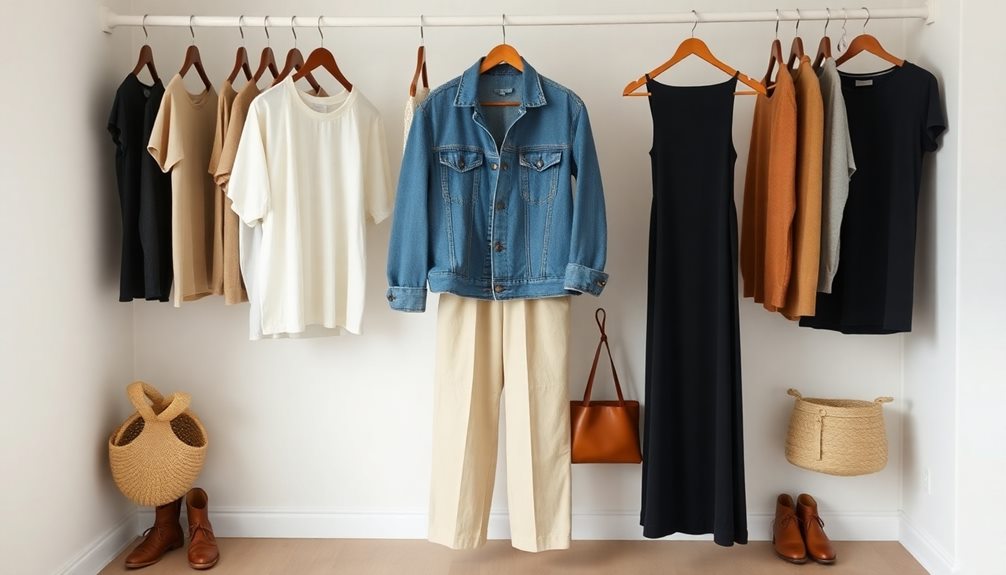
Building a sustainable fashion capsule wardrobe starts with a few essential pieces that form the foundation of your outfits. By focusing on capsule wardrobe essentials, you can create versatile outfits that make getting dressed a breeze. Aim for classic pieces in neutral colors, so everything you own can seamlessly mix and match.
Here's a quick overview of essential pieces for your wardrobe:
| Essential Piece | Description |
|---|---|
| Perfect White T-Shirt | A timeless staple for layering. |
| Tailored Trousers | Dressy yet comfortable for any occasion. |
| Classic Blue Jeans | Versatile and perfect for casual days. |
Invest in high-quality materials like organic cotton, linen, and wool to guarantee durability. As you build a minimalist wardrobe, don't forget key accessories like a statement handbag or silk scarf, as they can elevate your looks without adding bulk. Regularly reassessing and decluttering your wardrobe will help maintain a focused selection of essential pieces, allowing you to enjoy a stylish and sustainable fashion journey.
Steps to Build Your Capsule
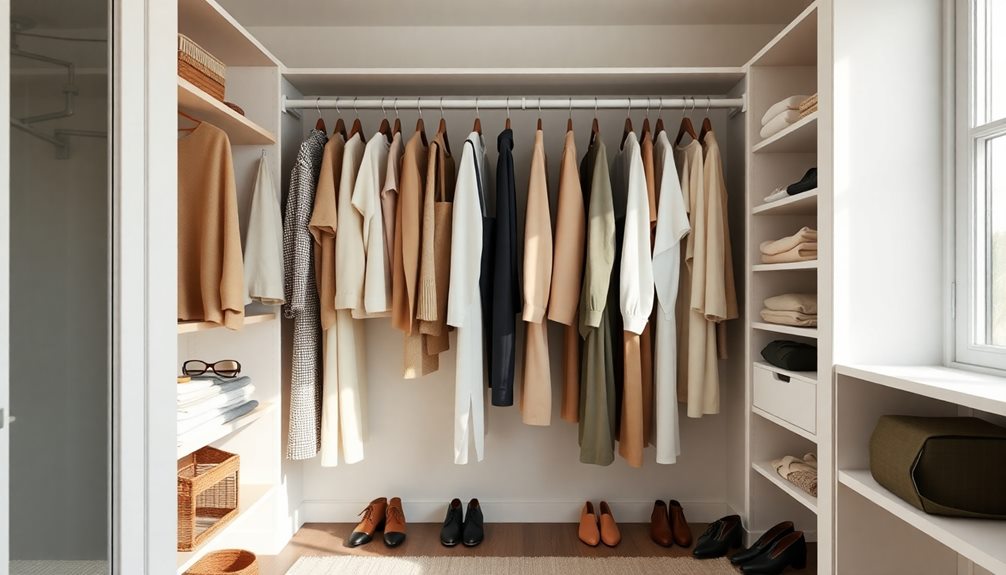
To build your capsule wardrobe, start by evaluating your current collection to pinpoint the pieces you wear most.
Next, focus on selecting versatile core items that can easily mix and match, ensuring you have a cohesive and functional outfit lineup.
Assess Your Current Wardrobe
When you're ready to create your capsule wardrobe, start by evaluating each item in your current collection. Look for your favorite pieces—those you frequently wear and love. Set aside items that haven't seen the light of day in over a year; consider donating or selling them. This will help you declutter and focus on what truly matters.
Create a designated space for your capsule wardrobe items. This not only makes it easier to visualize what you have but also assists in planning potential outfits. Keep a capsule wardrobe checklist handy that includes essential wardrobe pieces that align with your personal style. Aim for high-quality items that can mix and match for maximum versatility.
As you assess your current wardrobe, consider your lifestyle and daily activities. Verify the selected items cater to various occasions—whether casual, work, or formal.
Take note of any gaps in your collection during this process. This awareness can guide future purchases toward sustainable brands or second-hand options that complement your capsule wardrobe, verifying it remains both stylish and eco-friendly.
Select Versatile Core Pieces
After evaluating your current wardrobe and decluttering, it's time to focus on selecting versatile core pieces that will form the backbone of your capsule collection. Start by identifying the clothing items you frequently wear and love. Aim for a minimalist range of 30-40 core pieces, prioritizing classic styles that mix and match seamlessly.
Consider essential categories like basic tops, tailored bottoms, and outerwear that adapt well between seasons. This adaptability will keep your capsule wardrobe functional in various climates.
When choosing your core pieces, think about how they can create a cohesive look. A well-curated color palette, primarily made up of neutrals with a few accent colors, will maximize your outfit combinations while maintaining a polished appearance.
Don't forget to regularly evaluate your capsule wardrobe. As seasons change or your personal style evolves, be open to updates. Following a one-in-one-out policy helps keep clutter at bay, ensuring that each piece you own serves a purpose.
Create Outfit Combinations
Building a variety of outfit combinations is key to maximizing the potential of your capsule wardrobe. Start by selecting 7-10 core pieces that can easily mix and match. Focus on a neutral color palette and timeless styles, ensuring everything coordinates seamlessly. This approach allows you to create multiple outfits for various occasions.
Experiment with layering to enhance your versatility. For instance, pair a classic blazer with a turtleneck and tailored trousers for a polished look. Alternatively, wear a casual tee with jeans for a relaxed vibe. By mixing different items, you can keep your outfits fresh and stylish.
Don't forget to incorporate accessories! Scarves, statement jewelry, and belts can elevate your basic outfits and showcase your personal flair without needing more clothing. These small additions can transform a simple look into something special.
Regularly reassess your outfit combinations to identify any gaps in your wardrobe. This reflection helps you make intentional future purchases that enhance your capsule's versatility and sustainability.
With a little creativity, you'll discover countless outfit combinations that make the most of your sustainable fashion choices. By mixing and matching pieces, layering thoughtfully, and accessorizing strategically, you can elevate your wardrobe while staying eco-conscious. Mastering dress design techniques can further enhance your ability to customize and refresh existing garments, giving them new life and reducing waste. This not only promotes sustainability but also allows you to express your unique style in a truly innovative way.
Styling Tips for Versatility
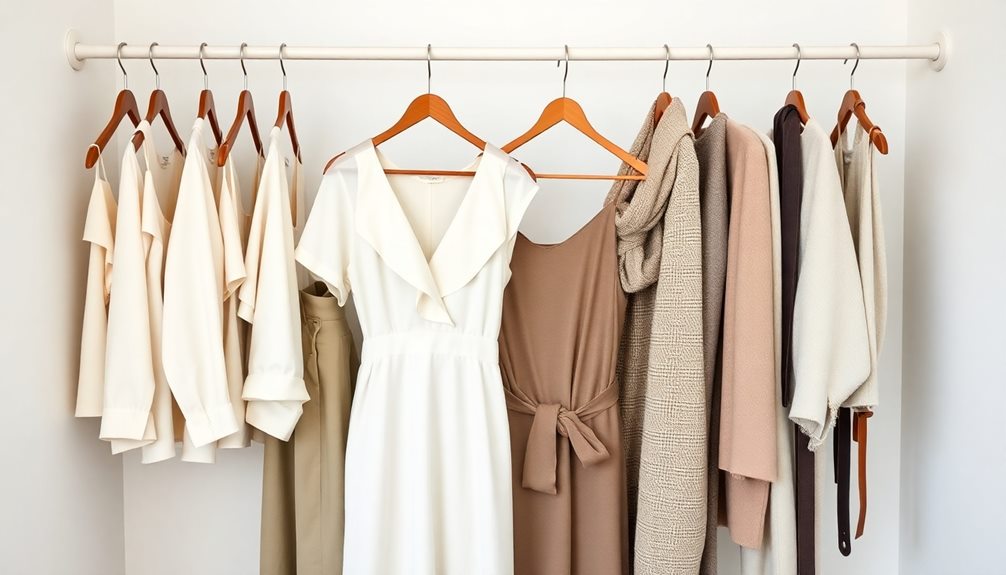
To maximize versatility in your capsule wardrobe, layering plays an essential role. Combining lighter tops with heavier outerwear allows for seamless shifts between seasons and occasions. You can elevate your outfits by experimenting with different accessories, which can dramatically change the vibe. For example, swapping a basic tee with a statement necklace or a colorful scarf can instantly transform your look.
When it comes to footwear, don't hesitate to mix it up! Switching between sneakers, ankle boots, and flats can alter an outfit from casual to polished in seconds. Remember to utilize the rule of thirds in styling; balancing fitted and loose pieces creates a visually appealing silhouette.
To help you plan and inspire new combinations, consider creating a visual inventory of potential outfits from your capsule wardrobe. Here's a quick reference table for layering and styling options:
| Layering Option | Footwear Choices |
|---|---|
| Light Tee + Cardigan | Sneakers |
| Blouse + Blazer | Ankle Boots |
| Tank + Denim Jacket | Flats |
| Dress + Sweater | Heeled Sandals |
| Tunic + Long Coat | Combat Boots |
Incorporating these tips will enhance your wardrobe's versatility!
Incorporating Accessories Effectively
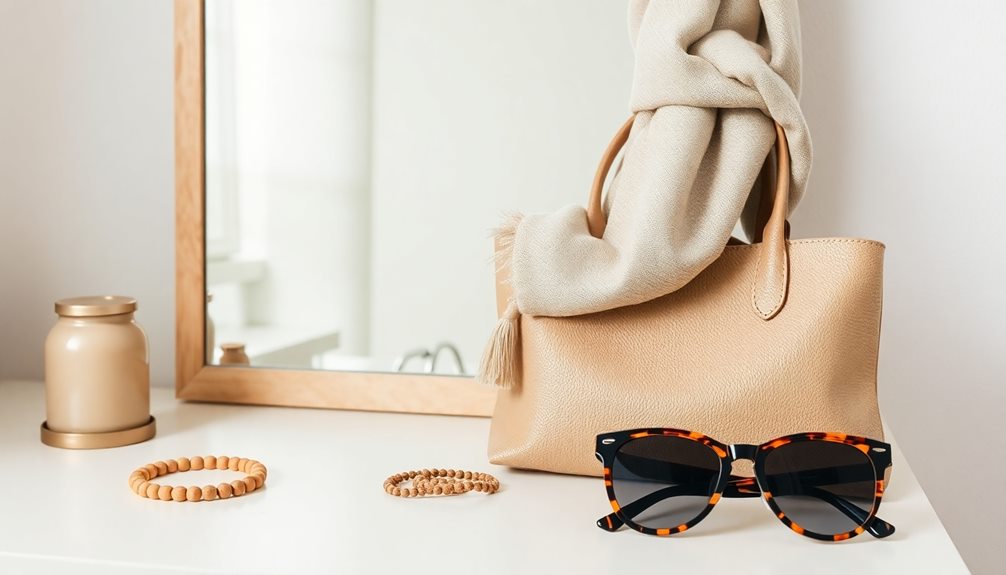
Accessories offer a fantastic way to elevate your capsule wardrobe while adding a personal touch. By incorporating versatile accessories, you can transform a basic outfit into a stylish ensemble. For instance, a bold necklace or a colorful scarf can inject personality into your wardrobe's neutral palette.
Quality items like a leather belt or a classic handbag enhance functionality, making it easy to shift from casual to formal settings. Layering accessories, such as stacking rings or layered necklaces, adds depth to your look, allowing you to express creativity while maintaining a minimalist aesthetic.
Opt for eco-friendly choices made from sustainable materials, like recycled metals or organic textiles, to reinforce your commitment to sustainable fashion. Minimalist accessories, like simple stud earrings or a silk scarf, provide an elegant touch without overwhelming your outfit, keeping the focus on your core pieces.
Seasonal Adaptations for Your Wardrobe
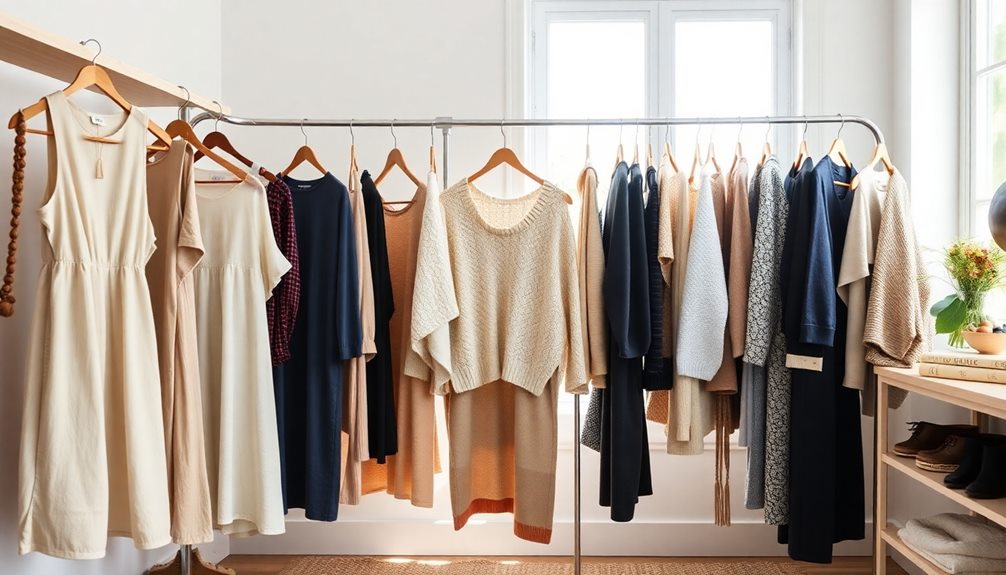
Adapting your capsule wardrobe for the changing seasons is essential for maintaining both style and comfort. Start by making seasonal adaptations that reflect the current climate. Swap out lighter fabrics and brighter colors for the warmth of fall and winter. Incorporate layering pieces like a lightweight trench for spring or a cozy wool sweater for winter, guaranteeing you can mix and match throughout the year.
Regularly assess your wardrobe to rotate seasonal essentials, which keeps your outfits fresh and relevant. Aim for versatile pieces that work across different seasons, maximizing your outfit combinations.
Don't forget about accessories; scarves and hats can shift easily between seasons while enhancing your overall style without cluttering your space.
When planning your seasonal wardrobe, pay attention to upcoming events and weather forecasts. This way, you'll confirm your selections are both functional and suitable for various occasions.
Managing Non-Capsule Items
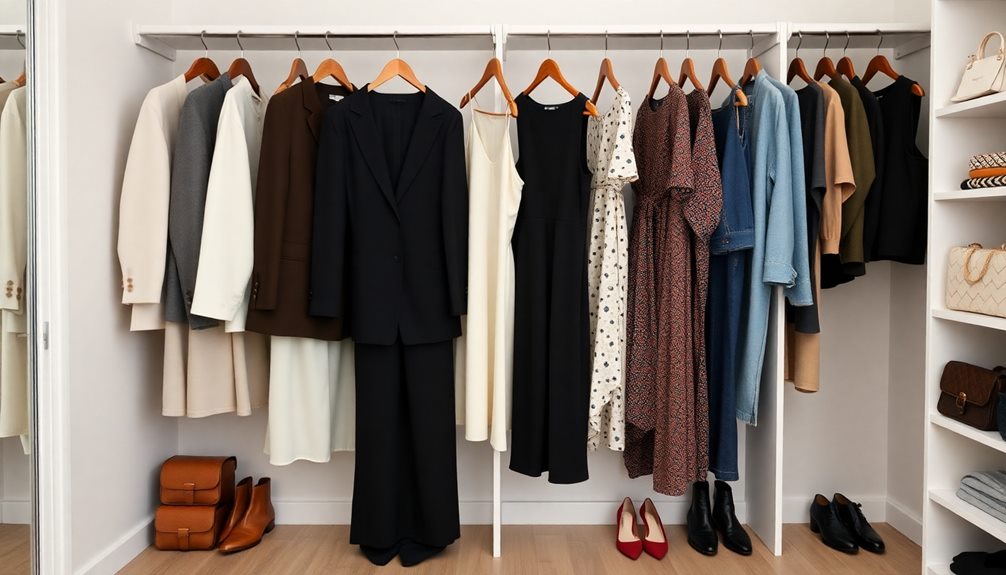
When it comes to managing non-capsule items, regular reassessment is key to maintaining a streamlined wardrobe. Every 30 days, take a moment to evaluate these pieces. Ask yourself if they're still relevant or if they can be donated or sold. This practice promotes a clutter-free space and keeps your wardrobe fresh.
To further reduce decision fatigue, create a dedicated section in your closet for your capsule pieces. This way, you can easily distinguish them from non-capsule items, making outfit selection a breeze.
Implementing a "one-in-one-out" rule is also essential. Whenever you purchase something new, choose an outdated or unused item to remove, ensuring you don't accumulate unnecessary clothing.
Consider planning outfits that use your core capsule pieces as a base. This allows you to experiment with non-capsule items as accessories or layering pieces, adding versatility to your looks.
Additionally, maintain a visual inventory of your non-capsule items. This strategy helps you identify gaps in your wardrobe and discover potential outfit combinations, enhancing your creativity while managing overall clothing volume.
Sustainable Fashion Brands to Consider

Building a sustainable wardrobe starts with selecting the right brands that align with your values. Search no further than Patagonia, a leader in sustainable fashion that uses recycled materials in over 70% of its products.
They even commit 1% of their sales to environmental causes, making each purchase impactful.
Everlane emphasizes transparency in pricing and sourcing, offering ethically made clothing crafted from sustainable materials like organic cotton and recycled polyester.
Reformation takes it a step further by calculating the environmental impact of each item, aiming to be climate-positive by 2025 with its eco-friendly practices.
Don't overlook People Tree, a pioneer in fair trade fashion. They produce garments using organic cotton and guarantee fair wages throughout their supply chain.
Frequently Asked Questions
What Is the 333 Method Capsule Wardrobe?
The 333 Method Capsule Wardrobe involves curating 33 clothing items for three months. You'll mix and match three tops, bottoms, and shoes, simplifying your style while reducing decision fatigue and wardrobe clutter.
What Are the 37 Items in a Capsule Wardrobe?
When building your capsule wardrobe, consider including items like versatile tops, classic bottoms, outerwear, and essential footwear. Aim for around 37 pieces that mix and match easily, ensuring you've got stylish options for every occasion.
What Are the Classic Pieces for Capsule Wardrobe?
Imagine opening your closet to find the perfect essentials: a crisp white t-shirt, tailored black trousers, and a versatile little black dress. These classic pieces effortlessly create endless outfit possibilities, making getting dressed a breeze.
What Should a Capsule Wardrobe Contain?
A capsule wardrobe should contain versatile basics like a white t-shirt, tailored trousers, and a classic blazer. Include comfortable footwear and minimal accessories to mix and match easily, ensuring you're always stylishly prepared for any occasion.
Conclusion
Creating a sustainable fashion capsule wardrobe is like planting a garden; with careful selection and nurturing, it flourishes beautifully over time. By investing in essential pieces and embracing versatility, you not only simplify your life but also contribute to a more eco-friendly world. Remember, it's about quality over quantity—each item should reflect your style and values. So, take the leap, curate your wardrobe, and enjoy the freedom that comes with a thoughtfully crafted collection.
